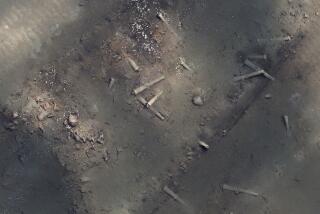San Diego History : Cabrillo’s Voyage
- Share via
In 1542, two years after Hernando Cortes retired as Viceroy of Mexico and returned to Spain, Juan Cabrillo received a commission to find a sea route to the Atlantic Ocean, around what was then believed to be the island of California.
Cabrillo’s ships were dismantled on Mexico’s Caribbean shore, carried by pack mules over rugged mountains and through dense jungles, then reassembled by 40 shipwrights and local Indians. The ship, the flagship San Salvador and the smaller La Victoria, are believed to be the first vessels built on the Pacific coast.
The ships were of the Lateener design, with the triangular sails used on European coastal vessels for nearly seven centuries. The San Salvador was 75-feet long and had a displacement of 100 tons.
Cabrillo sailed from the port of Navidad in June 1542, and voyaged up the coast of Baja, arriving at Point Loma on Sept. 28. He christened the newly discovered bay San Miguel, where he stayed six days.
His explorations carried him as far north as Cape Mendocino, where he was finally driven south by severe storms. Cabrillo attempted to land his ship in turbulent surf off the island of San Miguel-the same name given San Diego Bay. He broke his leg and later died from complications.
Why Spain Sent Explorers
In 1494, two years after Columbus’ voyage of discovery, Pope Alexander VI, fearing Spain and Portugal would clash in the New World, issued a Papal Bull dividing the globe at a point 1,100-miles west of the Azores. Land discovered East of the line would belong to Portugal; those to the West were Spain’s.
More to Read
Sign up for Essential California
The most important California stories and recommendations in your inbox every morning.
You may occasionally receive promotional content from the Los Angeles Times.





![Vista, California-Apri 2, 2025-Hours after undergoing dental surgery a 9-year-old girl was found unresponsive in her home, officials are investigating what caused her death. On March 18, Silvanna Moreno was placed under anesthesia for a dental surgery at Dreamtime Dentistry, a dental facility that "strive[s] to be the premier office for sedation dentistry in Vitsa, CA. (Google Maps)](https://ca-times.brightspotcdn.com/dims4/default/07a58b2/2147483647/strip/true/crop/2016x1344+29+0/resize/840x560!/quality/75/?url=https%3A%2F%2Fcalifornia-times-brightspot.s3.amazonaws.com%2F78%2Ffd%2F9bbf9b62489fa209f9c67df2e472%2Fla-me-dreamtime-dentist-01.jpg)







